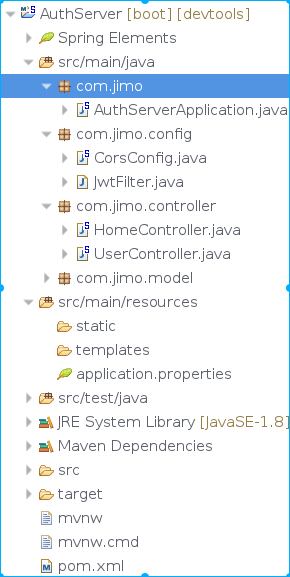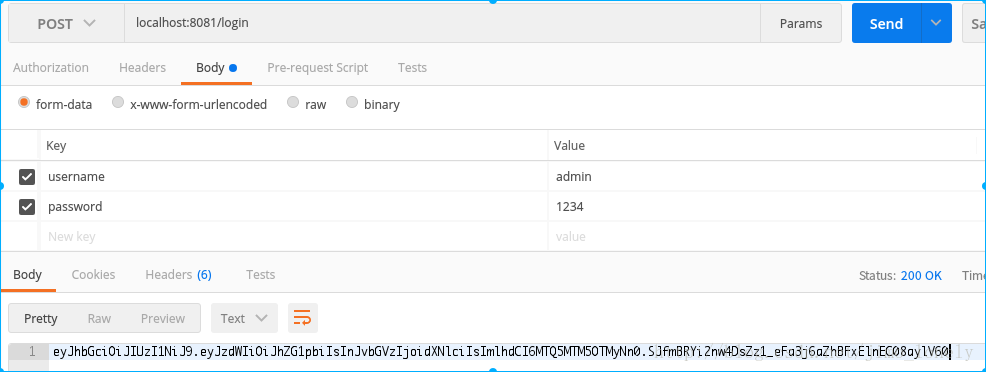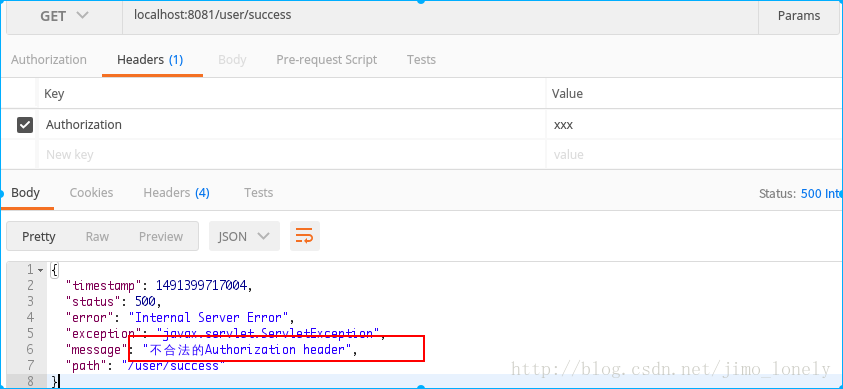前后端分離的思想由來已久,不妨嘗試一下,從上手開始,先把代碼寫出來再究細節。
代碼下載:https://github.com/jimolonely/AuthServer
前言
以前服務端為什么能識別用戶呢?對,是session,每個session都存在服務端,瀏覽器每次請求都帶著sessionId(就是一個字符串),于是服務器根據這個sessionId就知道是哪個用戶了。
那么問題來了,用戶很多時,服務器壓力很大,如果采用分布式存儲session,又可能會出現不同步問題,那么前后端分離就很好的解決了這個問題。
前后端分離思想:
在用戶第一次登錄成功后,服務端返回一個token回來,這個token是根據userId進行加密的,密鑰只有服務器知道,然后瀏覽器每次請求都把這個token放在Header里請求,這樣服務器只需進行簡單的解密就知道是哪個用戶了。這樣服務器就能專心處理業務,用戶多了就加機器。當然,如果非要討論安全性,那又有說不完的話題了。
下面通過SpringBoot框架搭建一個后臺,進行token構建。
構建springboot項目
我的目錄結構:(結果未按標準書寫,僅作說明)

不管用什么IDE,最后我們只看pom.xml里的依賴:
為了盡可能簡單,就不連數據庫了,登陸時用固定的。
devtools:用于修改代碼后自動重啟;
jjwt:加密這么麻煩的事情可以用現成的,查看https://github.com/jwtk/jjwt
|
1
2
3
4
5
6
7
8
9
10
11
12
13
14
15
16
17
18
19
20
21
22
23
24
25
26
27
28
29
30
31
32
33
34
35
36
37
38
|
<parent> <groupId>org.springframework.boot</groupId> <artifactId>spring-boot-starter-parent</artifactId> <version>1.5.2.RELEASE</version> <relativePath /> <!-- lookup parent from repository --> </parent> <properties> <project.build.sourceEncoding>UTF-8</project.build.sourceEncoding> <project.reporting.outputEncoding>UTF-8</project.reporting.outputEncoding> <java.version>1.8</java.version> </properties> <dependencies> <dependency> <groupId>org.springframework.boot</groupId> <artifactId>spring-boot-starter-web</artifactId> </dependency> <!-- JJWT --> <dependency> <groupId>io.jsonwebtoken</groupId> <artifactId>jjwt</artifactId> <version>0.6.0</version> </dependency> <dependency> <groupId>org.springframework.boot</groupId> <artifactId>spring-boot-devtools</artifactId> <optional>true</optional> </dependency> <dependency> <groupId>org.springframework.boot</groupId> <artifactId>spring-boot-starter-test</artifactId> <scope>test</scope> </dependency> </dependencies> |
登錄
這里的加密密鑰是:base64EncodedSecretKey
|
1
2
3
4
5
6
7
8
9
10
11
12
13
14
15
16
17
18
19
20
21
22
23
24
25
26
27
28
29
30
31
32
|
import java.util.Date;import javax.servlet.ServletException;import org.springframework.web.bind.annotation.PostMapping;import org.springframework.web.bind.annotation.RequestBody;import org.springframework.web.bind.annotation.RequestMapping;import org.springframework.web.bind.annotation.RequestParam;import org.springframework.web.bind.annotation.RestController;import io.jsonwebtoken.Jwts;import io.jsonwebtoken.SignatureAlgorithm;@RestController@RequestMapping("/")public class HomeController { @PostMapping("/login") public String login(@RequestParam("username") String name, @RequestParam("password") String pass) throws ServletException { String token = ""; if (!"admin".equals(name)) { throw new ServletException("找不到該用戶"); } if (!"1234".equals(pass)) { throw new ServletException("密碼錯誤"); } token = Jwts.builder().setSubject(name).claim("roles", "user").setIssuedAt(new Date()) .signWith(SignatureAlgorithm.HS256, "base64EncodedSecretKey").compact(); return token; }} |
測試token
現在就可以測試生成的token了,我們采用postman:

過濾器
這肯定是必須的呀,當然,也可以用AOP。
過濾要保護的url,同時在過濾器里進行token驗證
token驗證:
|
1
2
3
4
5
6
7
8
9
10
11
12
13
14
15
16
17
18
19
20
21
22
23
24
25
26
27
28
|
public class JwtFilter extends GenericFilterBean { @Override public void doFilter(ServletRequest req, ServletResponse res, FilterChain chain) throws IOException, ServletException { HttpServletRequest request = (HttpServletRequest) req; HttpServletResponse response = (HttpServletResponse) res; String authHeader = request.getHeader("Authorization"); if ("OPTIONS".equals(request.getMethod())) { response.setStatus(HttpServletResponse.SC_OK); chain.doFilter(req, res); } else { if (authHeader == null || !authHeader.startsWith("Bearer ")) { throw new ServletException("不合法的Authorization header"); } // 取得token String token = authHeader.substring(7); try { Claims claims = Jwts.parser().setSigningKey("base64EncodedSecretKey").parseClaimsJws(token).getBody(); request.setAttribute("claims", claims); } catch (Exception e) { throw new ServletException("Invalid Token"); } chain.doFilter(req, res); } }} |
要保護的url:/user下的:
|
1
2
3
4
5
6
7
8
9
10
11
12
13
14
15
|
@SpringBootApplicationpublic class AuthServerApplication { @Bean public FilterRegistrationBean jwtFilter() { FilterRegistrationBean rbean = new FilterRegistrationBean(); rbean.setFilter(new JwtFilter()); rbean.addUrlPatterns("/user/*");// 過濾user下的鏈接 return rbean; } public static void main(String[] args) { SpringApplication.run(AuthServerApplication.class, args); }} |
UserController
這個是必須經過過濾才可以訪問的:
|
1
2
3
4
5
6
7
8
9
10
11
12
13
14
|
@RestController@RequestMapping("/user")public class UserController { @GetMapping("/success") public String success() { return "恭喜您登錄成功"; } @GetMapping("/getEmail") public String getEmail() { return "xxxx@qq.com"; }} |
關鍵測試
假設我們的Authorization錯了,肯定是通不過的:

當輸入剛才服務器返回的正確token:

允許跨域請求
現在來說前端和后端是兩個服務器了,所以需要允許跨域:
|
1
2
3
4
5
6
7
8
9
10
11
12
13
14
15
16
17
18
19
20
21
22
23
24
25
26
27
28
29
30
31
32
|
@Configurationpublic class CorsConfig { @Bean public FilterRegistrationBean corsFilter() { UrlBasedCorsConfigurationSource source = new UrlBasedCorsConfigurationSource(); CorsConfiguration config = new CorsConfiguration(); config.setAllowCredentials(true); config.addAllowedOrigin("*"); config.addAllowedHeader("*"); config.addAllowedMethod("OPTION"); config.addAllowedMethod("GET"); config.addAllowedMethod("POST"); config.addAllowedMethod("PUT"); config.addAllowedMethod("HEAD"); config.addAllowedMethod("DELETE"); source.registerCorsConfiguration("/**", config); FilterRegistrationBean bean = new FilterRegistrationBean(new CorsFilter(source)); bean.setOrder(0); return bean; } @Bean public WebMvcConfigurer mvcConfigurer() { return new WebMvcConfigurerAdapter() { @Override public void addCorsMappings(CorsRegistry registry) { registry.addMapping("/**").allowedMethods("GET", "PUT", "POST", "GET", "OPTIONS"); } }; }} |
下次是采用VueJS寫的前端如何請求。
以上就是本文的全部內容,希望對大家的學習有所幫助,也希望大家多多支持服務器之家。
原文鏈接:http://blog.csdn.net/jimo_lonely/article/details/69357365














